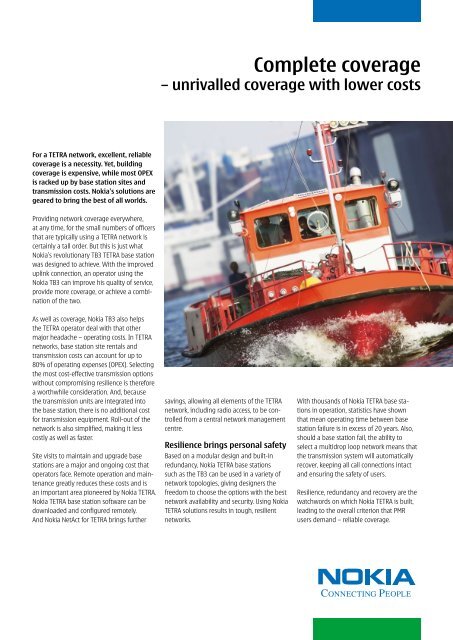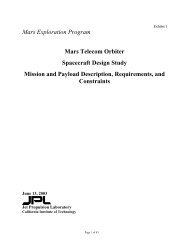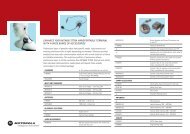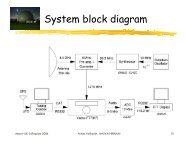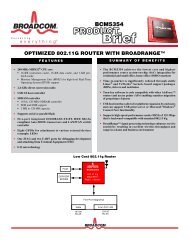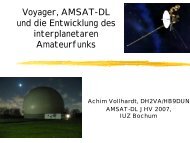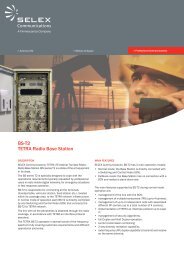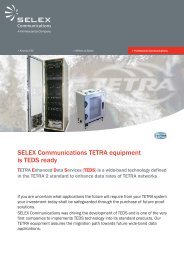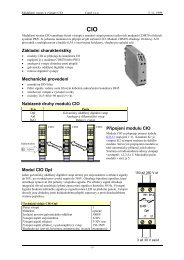Nokia TB3 TETRA base station
Nokia TB3 TETRA base station
Nokia TB3 TETRA base station
You also want an ePaper? Increase the reach of your titles
YUMPU automatically turns print PDFs into web optimized ePapers that Google loves.
Complete coverage<br />
– unrivalled coverage with lower costs<br />
For a <strong>TETRA</strong> network, excellent, reliable<br />
coverage is a necessity. Yet, building<br />
coverage is expensive, while most OPEX<br />
is racked up by <strong>base</strong> <strong>station</strong> sites and<br />
transmission costs. <strong>Nokia</strong>’s solutions are<br />
geared to bring the best of all worlds.<br />
Providing network coverage everywhere,<br />
at any time, for the small numbers of officers<br />
that are typically using a <strong>TETRA</strong> network is<br />
certainly a tall order. But this is just what<br />
<strong>Nokia</strong>’s revolutionary <strong>TB3</strong> <strong>TETRA</strong> <strong>base</strong> <strong>station</strong><br />
was designed to achieve. With the improved<br />
uplink connection, an operator using the<br />
<strong>Nokia</strong> <strong>TB3</strong> can improve his quality of service,<br />
provide more coverage, or achieve a combination<br />
of the two.<br />
As well as coverage, <strong>Nokia</strong> <strong>TB3</strong> also helps<br />
the <strong>TETRA</strong> operator deal with that other<br />
major headache – operating costs. In <strong>TETRA</strong><br />
networks, <strong>base</strong> <strong>station</strong> site rentals and<br />
transmission costs can account for up to<br />
80% of operating expenses (OPEX). Selecting<br />
the most cost-effective transmission options<br />
without compromising resilience is therefore<br />
a worthwhile consideration. And, because<br />
the transmission units are integrated into<br />
the <strong>base</strong> <strong>station</strong>, there is no additional cost<br />
for transmission equipment. Roll-out of the<br />
network is also simplified, making it less<br />
costly as well as faster.<br />
Site visits to maintain and upgrade <strong>base</strong><br />
<strong>station</strong>s are a major and ongoing cost that<br />
operators face. Remote operation and maintenance<br />
greatly reduces these costs and is<br />
an important area pioneered by <strong>Nokia</strong> <strong>TETRA</strong>.<br />
<strong>Nokia</strong> <strong>TETRA</strong> <strong>base</strong> <strong>station</strong> software can be<br />
downloaded and configured remotely.<br />
And <strong>Nokia</strong> NetAct for <strong>TETRA</strong> brings further<br />
savings, allowing all elements of the <strong>TETRA</strong><br />
network, including radio access, to be controlled<br />
from a central network management<br />
centre.<br />
Resilience brings personal safety<br />
Based on a modular design and built-in<br />
redundancy, <strong>Nokia</strong> <strong>TETRA</strong> <strong>base</strong> <strong>station</strong>s<br />
such as the <strong>TB3</strong> can be used in a variety of<br />
network topologies, giving designers the<br />
freedom to choose the options with the best<br />
network availability and security. Using <strong>Nokia</strong><br />
<strong>TETRA</strong> solutions results in tough, resilient<br />
networks.<br />
With thousands of <strong>Nokia</strong> <strong>TETRA</strong> <strong>base</strong> <strong>station</strong>s<br />
in operation, statistics have shown<br />
that mean operating time between <strong>base</strong><br />
<strong>station</strong> failure is in excess of 20 years. Also,<br />
should a <strong>base</strong> <strong>station</strong> fail, the ability to<br />
select a multidrop loop network means that<br />
the transmission system will automatically<br />
recover, keeping all call connections intact<br />
and ensuring the safety of users.<br />
Resilience, redundancy and recovery are the<br />
watchwords on which <strong>Nokia</strong> <strong>TETRA</strong> is built,<br />
leading to the overall criterion that PMR<br />
users demand – reliable coverage.
<strong>Nokia</strong> <strong>TB3</strong> <strong>TETRA</strong> <strong>base</strong> <strong>station</strong> – Data sheet<br />
<strong>Nokia</strong> code: 11225 – 1104 Spokesman/Libris<br />
Copyright © 2004 <strong>Nokia</strong>. All rights reserved. <strong>Nokia</strong> and <strong>Nokia</strong> Connecting People are registered trademarks of <strong>Nokia</strong> Corporation.<br />
Other product and company names mentioned herein may be trademarks or trade names of respective owners.<br />
Products are subject to change without notice.<br />
Frequency bands<br />
• Tx: 380–390 MHz and Rx: 390–400 MHz<br />
Max. TBS power at top of cabinet<br />
• 25 W<br />
• 40 W (with combiner by-pass configuration and duplexer)<br />
Max power at TTRX output<br />
• 65 W<br />
Dynamic sensitivity at top of cabinet<br />
-113 dBm (TCH 7.2, BER 4%, TU50) without diversity<br />
< -112 dBm (according to EN 300 392-2) without diversity<br />
Static sensitivity at top of cabinet<br />
< -119 dBm (TCH 7.2, BER 4%) without diversity<br />
Receiver class<br />
• Class A and B EN 300 392-2<br />
Diversity reception<br />
• Maximum ratio combining (MRC) improving the uplink budget<br />
by 3...8dB compared to single receiver antenna solutions.<br />
Number of receivers per radio<br />
• 6 receivers with MRC for e.g. three-sector X-pol panel antennas<br />
Sectorized reception<br />
• Three sector topology improves receiver C/I by 5 dB compared<br />
to omnidirectional solution<br />
Duplex spacing<br />
• 10 MHz<br />
Switching range<br />
< 5 MHz<br />
Carrier spacing<br />
• 25 kHz<br />
Combiner options<br />
• Auto-tuned cavity. Manually tuned cavity. Wideband hybrid<br />
combiner with duplexers. Combiner by-pass with duplexer.<br />
Supply voltage options<br />
• 230 VAC (184 VAC...276 VAC)<br />
• -48 VDC (-36 VDC...-60 VDC)<br />
•-60 VDC (-44 VDC...-75 VDC)<br />
Power consumption<br />
• Nominal 0.5 kW with one TTRX at 65 W/100% duty cycle.<br />
• Max. 1.4 kW with four TTRXs keyed<br />
• Max. 2.5 kW with eight TTRXs keyed<br />
• Power consumption varies according to the traffic volume.<br />
Width x Height x Depth<br />
• 60 x 162 x 48 cm, one cabinet<br />
Weight (max.)<br />
• 200 kg (1 cabinet) 380 kg (2 cabinets)<br />
Operating temperature (ambient)<br />
• -10°C ...+55°C<br />
NOKIA CORPORATION<br />
Networks<br />
P.O. Box 325<br />
FIN-0045 <strong>Nokia</strong> GROUP, Finland<br />
Phone: +358 (0) 7180 08000<br />
www.nokia.com/tetra<br />
TBS transmit mode<br />
• Downlink continuous (D-CT) (as specified in the <strong>TETRA</strong> standard) Only<br />
carriers that are needed to carry the traffic are keyed.<br />
Transmission<br />
• Three E1 interfaces with inbuilt multiplexer and<br />
loop protection capability with remote configuration.<br />
• Support for satellite transmission.<br />
TBS management<br />
• Integrated into the DXT exchange<br />
O&M functions<br />
• Remote and local configuration. Remote and local alarm<br />
handling. Remote and local SW downloading. Remote and<br />
local test services. Eight remote outputs.<br />
Additional <strong>base</strong> <strong>station</strong> features<br />
• Superior and versatile coverage solutions<br />
• Intelligent Radio Resource Management<br />
• Fallback<br />
• Automatic Main Control Channel change-over<br />
• Standby TTRX for redundancy with optimised transmission<br />
• Modular design for redundant <strong>base</strong> <strong>station</strong> main units<br />
• Jamming detection<br />
• Dynamic air encryption with two simultaneous encryption<br />
algorithms<br />
• Adaptive random access window for congestion control<br />
• Additional signaling channel for Automatic Vehicle Location use<br />
• Load directed roaming<br />
• Dynamic channel allocation between voice or packet data Optional<br />
Global Positioning System (GPS)<br />
Values shown in the table are typical for network planning.<br />
Coverage with second-generation<br />
<strong>TETRA</strong> <strong>base</strong> <strong>station</strong>s<br />
Cell range<br />
with second-generation<br />
<strong>TETRA</strong> <strong>base</strong> <strong>station</strong>s<br />
Handheld radio coverage:<br />
indoor coverage<br />
in car coverage<br />
outdoor coverage<br />
no coverage<br />
Coverage with <strong>Nokia</strong> <strong>TB3</strong><br />
<strong>TETRA</strong> <strong>base</strong> <strong>station</strong>s<br />
With <strong>Nokia</strong> <strong>TB3</strong>,<br />
the cell range is extended<br />
No gaps in coverage<br />
Improved indoor coverage<br />
Gaps in coverage<br />
using secondgeneration<br />
<strong>TETRA</strong><br />
<strong>base</strong> <strong>station</strong>s


